Identifying and Preserving Wildlife Tracks
Some tracks may be as close as your own backyard, while others may require an extensive search.
Author: Extension Wildlife specialist, Department of Extension Animal Sciences and Natural Resources, New Mexico State University.
______________
Wild animals can be difficult to detect because of their instinctive behavior to avoid humans. However, the presence of wild animals often can be determined by their tacks in snow, sand, or soft mud. Many people have learned to read wildlife tracks with remarkable skill for hunting purposes. The art of tracking also allows wildlife biologists to identify habitats in which animals live and to conduct population surveys.
Animal tracks can be found in a variety of places. Some tracks may be as close as your own backyard, while others may require an extensive search. You can find animal tracks in desert sand dunes, along creek and marsh bottoms, in pastures, and along game trails. Once you have discovered the art of identifying wildlife tracks, you will probably never again pass a stream bank without instinctively looking to see what has passed by that area. You will find that a complex animal world, which you never suspected exists, has opened up for you.
However, reading tracks is not easy. Because each situation is somewhat different, you must be prepared to use your ingenuity to interpret what you see. In many cases you may not be able to identify the track you find because details of the animal’s feet are not present. For example, the track may not show all the toes. A track in the mud may look different from one in dust or snow, even if the same individual animal made them. In addition, a track in snow is different after the warm sun has enlarged and distorted it. There also are variations due to age and sex of the animal.
Frequently used wildlife paths or game trails are a common place to find tracks. The edge areas where two different habitat types meet probably provide the greatest potential for studying animal tracks. If you know of a place where animals habitually travel, as on a trail or near a den tree, then you can prepare a smooth area by sweeping the ground with a tree branch. Animals will leave good tracks under such controlled conditions. In addition, old tracks may be erased by smoothing this area over like a clean slate.
Identifying Wildlife Tracks
The following illustrations are designed to help you identify various species of wildlife by examining tracks. Several different characteristics are useful in differentiating the illustrated tracks. Pay special attention to characteristics such as track size, shape of track, and presence or absence of claw marks. Most tracks in this document are drawn to scale; however, track size can vary greatly for a species due to age, sex, and variation among individuals. Use the drawings in this publication as a guide rather than a rigid key because a perfect track is not always found.
There is no distinction between white-tailed deer and mule deer tracks in this document. These species can’t always be differentiated by their tracks. Therefore, the category “deer” was used to eliminate any problems. The same is true for the Rocky Mountain bighorn sheep and desert bighorn sheep. In some instances, it is impossible to differentiate the two sheep based on their tracks. Subsequently, the sheep tracks shown are titled “bighorn sheep” to eliminate any complications.
* Illustrations are not drawn to scale.
Deer
The shape of the deer track varies somewhat with the type of ground on which the animal lives. On soft soil, as in some woodlands, the toes are likely to be relatively more pointed. On hard, rocky ground the hoofs are worn enough to produce blunt tips. Generally the length of an adult deer track is between 2 3/8 and 3 1/4 inches. Tracks left by fawns are generally 1 3/8 inches long.
Front
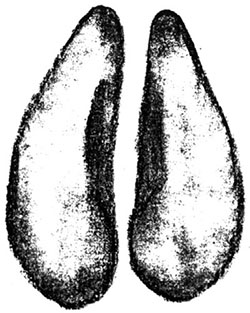
Hind
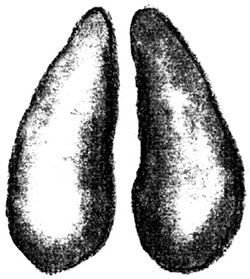
Elk
Elk tracks are definitely larger and rounder in outline than those of deer, so there is usually no difficulty in distinguishing them. Generally the length of an adult elk track is between 4 and 4 3/4 inches. In areas where elk share the same range with cattle, it can be difficult to distinguish the two. Adult cattle tracks are large and blocky, and quite distinct. But young cattle leave a track that is often very similar to that of adult elk. In such cases, look around for more distinctive tracks and for possible cow chips.
Front
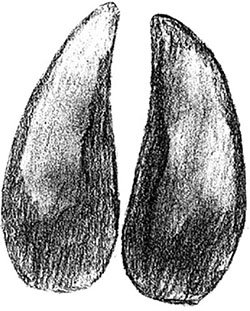
Front (running)
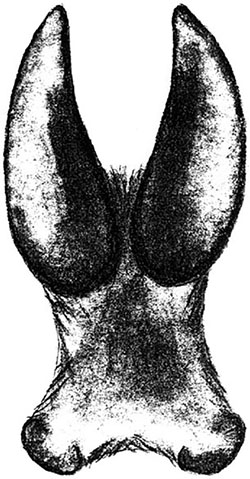
Pronghorn Antelope
Generally the front tracks are about 3 1/4 inches long, while the hind tracks are about 2 3/4 inches long for adults. Young pronghorn tracks are generally about 1 5/8 inches long. In some areas where mule deer share some of the range with pronghorn, their tracks may be confused. Although pronghorn tracks are much like those of deer, the pronghorn track tends to be more narrow toward the front.
Front
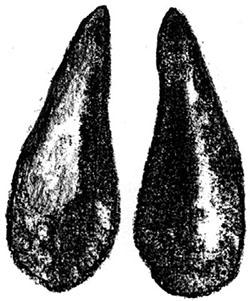
Hind
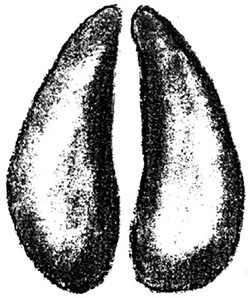
Bighorn Sheep
Bighorn sheep tracks also resemble deer tracks. However, the hooves of bighorn sheep have straighter edges, and the tracks do not often take the traditional heart shape. In other words, they tend to be more blocky and somewhat less pointed. Tracks of an adult bighorn sheep are generally 3 1/2 inches long, while tracks of a bighorn lamb are generally 2 inches long.
Front
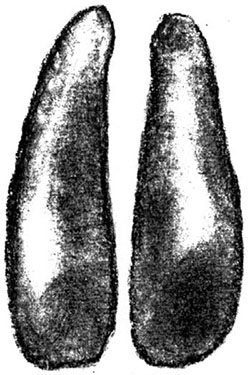
Mountain Lion
Mountain lion tracks rarely show the claws. As with other cats, the front foot is the larger, and the toes tend to spread widely when the animal is running. The width of tracks varies from 3 to more than 4 inches, and can be much greater in certain types of snow.
Front
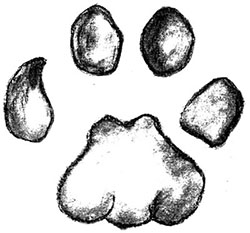
Hind
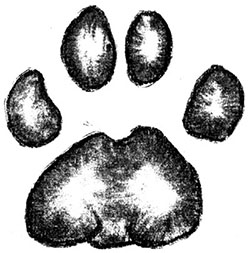
Wild animals can be difficult to detect because of their instinctive behavior to avoid humans. However, the presence of wild animals often can be determined by their tacks in snow, sand, or soft mud.
Bobcat
Bobcat tracks are fairly distinctive. A typical bobcat track is about 1 3/4 inches long by 1 7/8 inches wide. The track is more rounded than that of the coyote or dog and shows no claw marks. The ball pad of the bobcat is distinct from that of the coyote in that the front border is two-lobed. The principal difference between the front and hind tracks is the somewhat smaller ball pad of the hind foot. Tracks tend to be slightly longer than wide, though this is not always evident since it depends on the spread of the toes.
Front
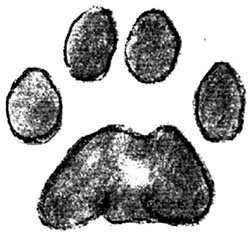
Hind
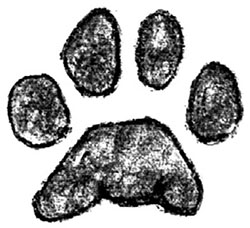
Coyote
The coyote’s front foot is larger than the hind foot. Front tracks in soft mud are 2 1/4 to 2 3/4 inches long and 1 3/4 to 2 3/8 inches wide. The hind tracks in mud are 2 to 2 3/8 inches long and 1 1/2 to 1 7/8 inches wide. Note the differing patterns in the heel pads of the front and hind tracks in the figure. When the imprint is not on soft ground, coyote tracks may not show the claws. Some dog tracks may be easily confused with coyote tracks even when the tracks are well defined. Coyote tracks tend to be more oval-shaped and compact than those of dogs. Nail marks also are less prominent, and the tracks tend to follow a straight line more closely than those of dogs.
Front
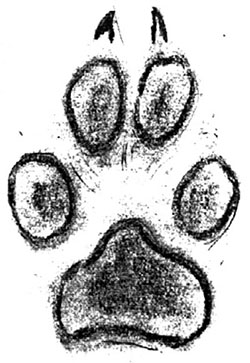
Hind
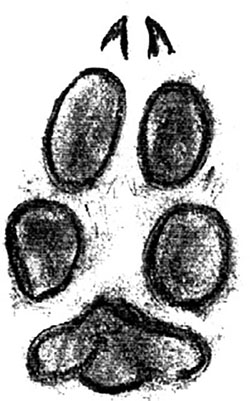
Raccoon
The raccoon track is distinctive and easily identified. Raccoons have five toes on the front and hind feet. In general the front tracks are about 2 1/4 inches long, while the hind tracks are about 3 1/8 inches long. Raccoon tracks also are usually paired, with the left hind foot placed beside the right forefoot as the animal walks along.
Front
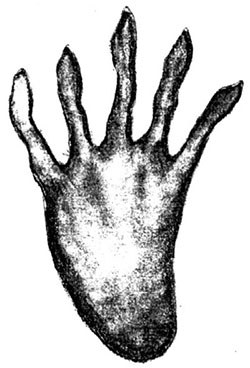
Hind
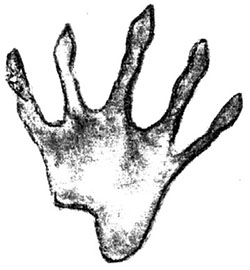
Black Bear
In general the front tracks are 3 1/2 inches wide, while the hind tracks are 7 inches long and 3 1/2 inches wide. The round pad of the front foot may not always register and the claw marks are not always present. The “big” toe of the bear foot is the outer one, not the inner one as with the human foot. Often the “little” (inside) toe leaves no mark in dust or shallow mud, so the footprint appears to be four-toed.
Front
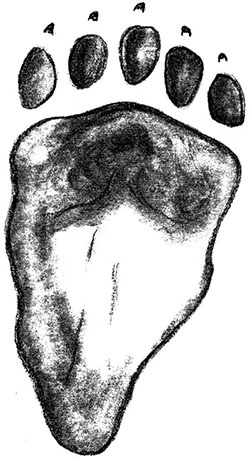
Hind
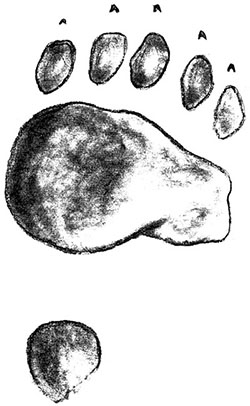
Preserving Wildlife Tracks
Preserving wildlife tracks can be both exciting and informative. For the field biologist, there may be an advantage in preserving for future study a clear record of wildlife tracks in a particular area. For the sports enthusiast or backpacker, who might make a hobby of tracking wild animals, it may be worthwhile to take home some souvenir tracks. When preserving tracks, you will also become more familiar with the characteristics of habitats in which animals live.
Under rare circumstances it may be possible to cut around the track with your knife and lift it out intact. This may be possible in the mud of a dried lake bottom where pronghorn or coyotes left footprints when the mud was just right for leaving a firm, sharp print. However, in most cases, plaster of Paris is used to make track casts for “take home” souvenirs.
Materials
- Strips of waxed cardboard (cut from milk carton) to make a collar 2 1/2 inches wide by 12 to 15 inches lon
- Plaster of Paris purchased at hardware stores, drug stores, or hobby shops
- A mixing stick
- A jar for storing the plaster
- Two tin cans (one for water and one for mixing)
- Water
- Paper clips
Making Track Casts
This method for making track casts is simple. First find a suitable track. The track should be deep enough to produce a solid cast and clear enough to reproduce. Remove all sticks and debris around the track. Make a circle around the print with the 2 1/2 inch-wide strips of cardboard; attach the ends with paper clips. Press the cardboard about 1/2 inch into the ground. The cardboard serves as an outer mold for the plaster. Pack some soil behind the cardboard for reinforcement.
Next, in the tin can mix the plaster of Paris with water while stirring with a stick until the mixture is the consistency of cream or pancake batter. A very thick plaster paste begins to set almost immediately. A thinner mixture gives you more time. If the plaster is too thick so that it doesn’t flow readily, it may dry too quickly and fail to reproduce some details of the feet. If too thin or watery, it will run all over the place, taking a long time to harden.
Now fill the track with the plaster, covering the inside mold to a depth of 1 inch below the top of the cardboard. When the plaster has been poured into the track, wait patiently for 10 minutes or more to allow it to set hard. It is not wise to attempt to pick up the cast too soon.
To pick up the cast after it is hard, cut around it with a knife, remove some dirt from under the edges all around the cast, then lift out the piece from a point well underneath the track. This cast is called a negative cast. Simply brush off the mud and dirt after the cast has had a day or more to harden.
For a positive cast (which can be made at home), form a waxed cardboard mold and fill with plaster of Paris mixture to the top of the mold. Cover the negative cast with a film of grease, vegetable shortening, or petroleum jelly. As soon as the mixture begins to set up, take the greased negative cast and carefully make an impression on the hardening plaster mixture. This will have to be done before the plaster mixture gets too hard, or the plaster will crack from the pressure exerted from the negative cast. With a little practice you can determine the necessary consistency for creating a positive cast that is a duplicate of the original track.
Precautions
Take great care if the track is in dry, dusty ground or sand. It may not be possible to acquire a good cast under such conditions. When attempting a cast in such a case, pour the solution directly into the track, but from a point as close above the track as possible. It should not be dropped in with any force. Tracks in snow also are difficult to cast. Even a fairly cold plaster solution tends to melt the bottom of the track and it can be frustrating to find that the batter has poured right on through. To avoid this, make sure the mixture is as cold as possible by stirring some snow in while mixing.


